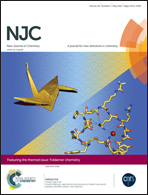Mineralization of malachite green dye over visible light responsive bismuth doped TiO2–ZrO2 ferromagnetic nanocomposites†
Abstract
We report enhanced visible light photocatalytic activity for ferromagnetic Bi doped (1% by atomic weight) TiO2–ZrO2 nanocomposites for the degradation of malachite green in aqueous solution. X-ray diffraction, Raman and High resolution Transmission electron microscopy (HRTEM) analysis indicate the presence of monoclinic ZrO2 and anatase TiO2 in the composite sample. The particle size of the nanocomposite is ∼20 nm. A significant absorption of visible light is observed for the doped TiO2 composite as compared to P25 and undoped TiO2–ZrO2. The photocatalytic activity of different concentrations of the TiO2–ZrO2 nanocomposite for the degradation of malachite green follows the order: 98% TiO2–2% ZrO2 < 80% TiO2–20% ZrO2 < 90% TiO2–10% ZrO2. The Bi doped TiO2–ZrO2 (90% TiO2–10% ZrO2) composite shows a still higher activity as compared to the undoped composite and commercial P25. TOC analysis exhibited 88% mineralization of malachite green over Bi doped TiO2–ZrO2 (90% TiO2–10% ZrO2). The enhanced photocatalytic activity of the doped TiO2–ZrO2 composite is attributed to improved visible light absorption and efficient separation of photogenerated charge carriers. The composite samples are found to be photo-stable and the photocatalytic activity remains almost the same for four cycles of degradation experiments. Testing with different quenchers suggest that hydroxyl radicals, holes and superoxide radicals play a considerable role in the photodegradation of malachite green. It is noteworthy that the Bi doped TiO2–ZrO2 nanocomposite exhibits defect induced room temperature ferromagnetism.


 Please wait while we load your content...
Please wait while we load your content...